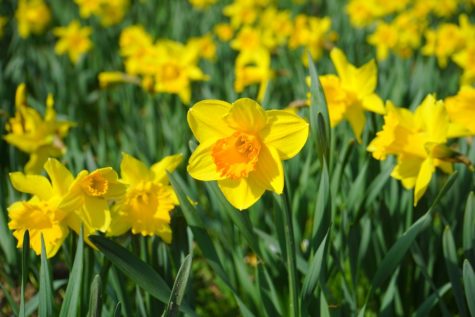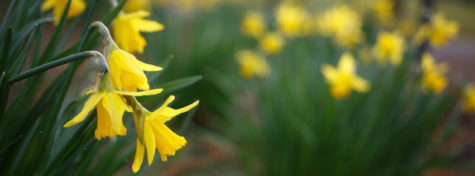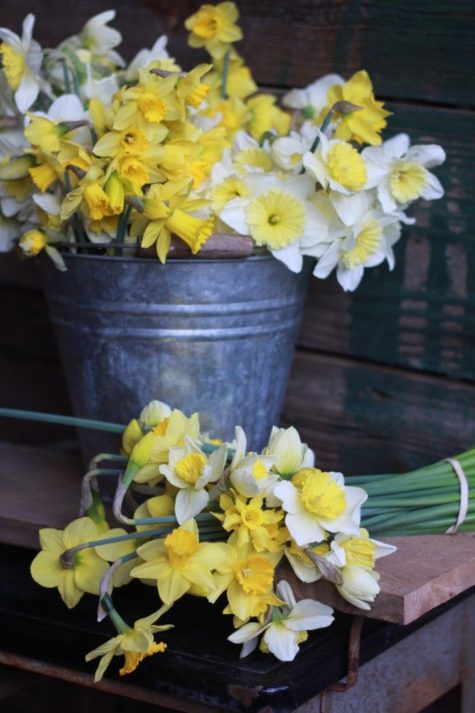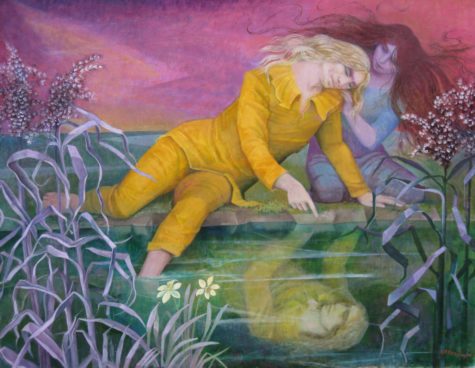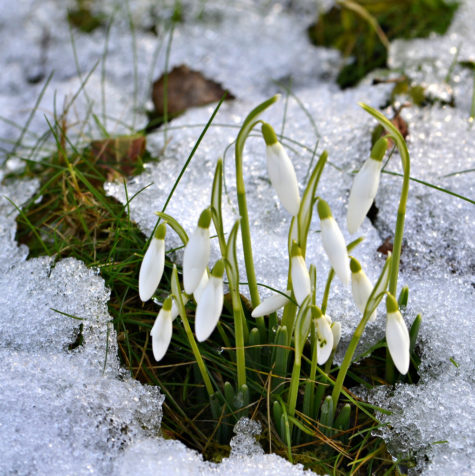Hope
- Ruler: Venus
- Element: Water
- Parts Used: The flowers, either fresh or dried.
- Powers: Love, fertility, luck
Symbolizing rebirth, resurrection, renewal and new beginnings, the daffodil is virtually synonymous with spring. Though their botanic name is narcissus, daffodils are sometimes called jonquils, and in England, because of their long association with Lent, they’re known as the “Lent Lily.”
The Daffodil is a calming flower that helps bring about inner peace, hope and, of course, self-love. It may also be used in spells related to unrequited love. To dream about seeing or picking daffodils is said to symbolize happiness and adoration.
The name daffodil is a derivitave of affodell, which is a variant of asphodel. The Latin name for the daffodil is narcissus. Narcissus are also referred to as jonquils in North America.
- The daffodil is the emblem of Wales and is worn on St David’s Day.
- For spring flowers the daffodil is one of the best bulbs to plant.
- As the daffodil is one of the first flowers of spring, it has the flower meaning of hope.
Daffodil commonly refers to narcissus with large trumpets, but may be used for all types of narcissus. This is the official common name for ANY of the plants that fall into the genus Narcissus. So, if the plant is considered a Narcissus, it is also considered a daffodil as well. However, most people use the term “daffodil” when referring to the large, trumpet-shaped flowers of the Narcissus pseudonarcissus.
For the magick and lore of the Narcissus, visit this post: Narcissus Magick and Lore
In Victorian flower language daffodils signified regard and chivalry, whilst narcissi meant self esteem, female ambition or vanity.The daffodil is the March birth flower and the meaning it holds is friendship and domestic happiness.
The March birth flower daffodil that is commonly known, is yellow with a sweet fragrance. It is native to the Mediterranean, but has been cultivated all over the world as a decorative plant. The daffodil is a perennial grown from a bulb. It can reach heights of two feet. The daffodil is a dependable spring flower and a favorite for its long life and colorful blooms. It is poisonous if eaten.
Lore connecting the daffodil to not only a sign of winter’s end but a lucky emblem of future prosperity is found throughout the world. In Wales, it’s said if you spot the first daffodil of the season, your next 12 months will be filled with wealth, and Chinese legend has it that if a daffodil bulb is forced to bloom during the New Year, it will bring good luck to your home.
The March birth flower and the 10th wedding anniversary flower, a gift of daffodils is said to ensure happiness. But always remember to present daffodils in a bunch – the same legends that associate this cheerful flower with good fortune warn us that when given as a single bloom, a daffodil can foretell misfortune.
Daffodils are suitable altar decorations for any rituals celebrating the coming of spring and suitable offerings for solar deities, water and nature spirits, especially those identified as female. It should be noted that daffodils are toxic, especially the bulbs and can cause irritation to the skin and so should be used with appropriate caution.
Through folkloric mention, narcissus is a flower of the dead and of the underworld, making it suitable for funerary rites as well as those related to the changing of the seasons through rebirth allegory.
- Sprinkle dried petals or place fresh flowers on an altar to attract friendly spirits.
- Keep in the house or garden to cheer you up.
- Wear a daffodil in your breast pocket for luck and to have a cheerful mood follow you all day.
- Add to bathwater to increase your luck and bring new people into your life.
- A bouquet of daffodils in the bedroom may increase fertility.
- Mix with rose petals and place around a photo of a lover you want to return to you.
- Keep freshly cut daffodils in a vase in your home to bring about abundance.
- Place daffodils on your altar during workings related to love, especially if it’s a new relationship and you’re still trying to figure out how to navigate the waters.
- Add potted daffodil bulbs, don’t worry if they’re blooming yet, to your altar for spring celebrations, along with other spring flowers such as forsythia, crocus, and snowdrops.
- Wear this flower close to your heart to draw love, but be careful that your love is not one-sided.
They are good flowers for Geminis who like the cheerfulness of the yellow color and Pisces who appreciate the delicate scent of the white narcissi.
Daffodils in Mythology
Daffodils are also known as the narcissus, after the legendary young Greek man of the same name. Narcissus was pretty full of himself because he had been given the gift of great beauty by the gods. One day, a sweet young wood nymph named Echo spotted Narcissus hanging out by a stream and instantly fell in love with him. However, he was so busy being completely self-absorbed that he ignored Echo, and she wasted away from loneliness until nothing was left of her but her voice. Thanks to this tragic story of unrequited love, daffodils are sometimes used to represent a love that is one-sided.
Later, the goddess Nemesis, although in some versions, it’s Venus, got wind of what had happened to Echo, so she decided it was time to teach Narcissus a lesson. She led him to a stream, where he happened to notice the most beautiful young man he had ever seen – it was his own reflection, and he was so vain that he fell in love with his own image, transfixed, and forgetting to eat and sleep. Some of the other gods were worried that Narcissus was going to starve to death, so they turned him into a flower, which now blooms every year in the spring.
Daffodils in Love
Despite the issues of Narcissus and Echo, daffodils still appear in some folklore as representative of holding a lover in high regard. They send the message that this person is the only one for you, and your feelings are constant.
In some Middle Eastern magic, daffodils are considered an aphrodisiac.
Spiritual Daffodils
One prominent legend of the daffodil features in Christianity. It is said that on the night of the Last Supper, the daffodil appeared in the Garden of Gethsemane to comfort Jesus, who was saddened to know of his betrayal by Judas Iscariot.
The occurrence of wild daffodils is sometimes said to indicate the former site of a religious foundation. At Frittlestoke, near Torrington, Devon, it was recorded in 1797 that the people of the village call daffodils by the name Gregories, a name that coincided with the order of a neighboring monastery – the Canons of St Gregory.
In both Hampshire and the Isle of Wight, it was generally said that wild daffodils indicated the site of a monastery. St Urian’s Copse is well known for its primroses and daffodils. There is a tradition that daffodils grow in profusion on one side of a track running through the copse because a religious building once stood there.
From:
- Encyclopedia of Magickal Ingredients
- Patti Wigington
- Encyclopedia of Superstitions
- Teleflora
- Scientific Name: Galianthus nivalis
- Common Names: Fair Maid of February; Bulbous Violet; Emblem of Early Spring; Maids of February; Candlemas Bells; Mary’s Tapers; Moly
- Type: Flower
- Parts Commonly Used: The flower
- Basic Powers: Hope, Friendship in adversity, Passing of sorrow,
Snowdrops are often assigned to the month of January, and I’m not sure why because these little flowers are also known as “Candlemas Bells”. February 2nd is Candlemas (Festival Day of Candles), and Imbolc. The ancient festival marks the midpoint of winter and some recognize it as the last day of the forty day Christmas season. In the catholic tradition, candles were brought into the church and blessed as a symbol of hope and light. In a time of no electric lights, candlelight offered great protection and comfort during the dark days of winter.
By producing their own heat, snowdrops actually melt the snow in their surroundings. Like candles, Snowdrops offer us our own light of hope in the grey of winter days. They are the emblems of friendship in adversity, harbingers of spring.
The first sight of snowdrops growing wild represents the passing of sorrow. In various religions, they are a sign from the gods that good times will come once more. According to one Christian tale, an angel turned falling snowflakes into flowers to give Adam and Eve a sign of hope after evicting them from the Garden of Eden.
The fact that snowdrops are often found, in abundance, in the old convent gardens, it was believed that this little white flower was sacred to virgins. For this reason, it was dedicated to the Virgin Mary. In some places, during the Candlemas celebration, it was customary for young women, wearing white gowns, to walk in procession carrying snowdrops in their hands.
It was often said that any one wearing a snowdrop would have only pure and lofty thoughts; and that if a young girl ate the first snowdrop she found in spring, neither sun nor wind would tan her that summer.
The snowdrop flower – which is well loved not only for its simple beauty, but for its distinct, honey-like scent – has a surprisingly varied history in both ancient folklore and more modern storytelling. In Grimm brother’s original version of the fairy tale nowadays known as Snow White, the main character’s name was actually Snow Drop.
Every spring on March 1, the national Moldovan holiday, is celebrated. On this day people present each other with the traditional flowers. One of the old Moldovan legend says that once in a fight with the winter witch, that didn’t want to give up its place, the beautiful lady Spring cut her finger and few drops of her blood fell on the snow, which melted. Soon on this place grew a snowdrop and in such a way the spring won the winter.
However, in some folklore, snowdrops are seen as unlucky. The reason for this is perhaps that they often grow in cemeteries and churchyards. Along with other white flowers, superstition says it is courting disaster to bring snowdrops into the house. To do so is to invite death into the home, can mean the parting of a loved one and, in the west country, is thought to cause eggs to turn addled. One should never even pick wild snowdrops, especially from a graveyard. The sight of a single snowdrop blooming in the garden foretells of impending disaster.
According to Are You Superstitious, by Lore Cowan, it is particularly unlucky to bring snowdrops, or “Candlemas bells”, into the house on February 2nd, which is Candlemas, or Imbolc, and if you wish to be married within the year you should not bring them into the house on Valentine’s Day, 14th February.
Snowdrops have their use in medicine. The alkaloid Galantamine, which was first isolated from snowdrops, has been used to treat Alzheimer’s disease, neuritis and neuralgia. In parts of eastern Europe, rubbing snowdrops on the forehead was at one time a folk remedy used as pain relief.
Andreas Plaitakis and Roger Duvoisin in 1983 suggested that the mysterious magical herb moly that appears in Homer’s Odyssey is actually snowdrop. An active substance in snowdrop is called galantamine, which, as an acetylcholinesterase inhibitor, could have acted as an antidote to Circe’s poisons.
Note: This post was compiled by Shirley Twofeathers for Magical Ingredients, you may repost and share without karmic repercussions, but only if you give me credit and a link back to this website. Blessed be.
